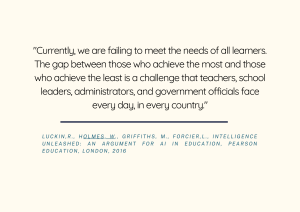Why Learn About AI
4 How AI Can Help You
When it comes to technology, there are two extremes to watch out for:
- Under-utilisation of technology due to fear and ignorance
- Indiscriminate use that might lead to undesirable secondary effects
For example, excessive use of mobile phones can be harmful. Some societies avoid mobile phones entirely. However, most people don’t overuse them. Prudent use of mobile technology has, in fact, saved lives.
In order to avoid succumbing to the first example above, it would be helpful to have knowledge of important educational applications. We will take a closer look at each of these in the upcoming chapters. Here are some examples.
AI tools for managing learning

Artificial intelligence dashboards, other data visualisation tools and learning management systems bring all the available information together. These help to monitor student performance over multiple subjects or track progress on any topic in classrooms of any size.
AI applications can flag potential problems, such as absenteeism and behaviour common to dropouts. All the data thus gathered can serve as self-assessment for the teacher by showing where the lessons are effective and where a change of approach is required.
AI is suitable for scheduling and resource-optimisation tasks. But the most important application is that which deals with inclusion and integration of the differently abled. Human-machine interface has never been as seamless as it is now, making multimedia input and output a real possibility. For example, the app Storysign helps translate words to sign language to help deaf children learn to read.
AI tools for personalising learning
 Adaptive learning systems (ALSs) evaluate the learner, be it through quizzes or real-time feedback. Based on this evaluation, they present the student with a predefined learning path. Instead of a one-size-fits-all approach, students can spend more or less time on each topic, explore new and related topics. This adaptive software can help them learn to read, write, pronounce and solve problems.
Adaptive learning systems (ALSs) evaluate the learner, be it through quizzes or real-time feedback. Based on this evaluation, they present the student with a predefined learning path. Instead of a one-size-fits-all approach, students can spend more or less time on each topic, explore new and related topics. This adaptive software can help them learn to read, write, pronounce and solve problems.- ALSs can also help learners with special needs. Any specialisation of the systems will be based on proven theories and expert opinion. Targeted systems “are likely to be of great assistance in teaching individuals with cognitive disabilities such as Down Syndrome, traumatic brain injury, or dementia, as well as for less severe cognitive conditions such as dyslexia, attention deficit disorder and dyscalculia”1.
- Different groups can be formed for different activities (‘clustering‘), taking into account the individual strengths and weaknesses of each member.
While these technologies can help, “the devil is in the detail of how you actually use the technology”2. The same innovative and powerful learning technology can be used effectively in one school – and badly in another2.
Again, knowledge is the key!
1 Alkhatlan, A., Kalita, J.K., Intelligent Tutoring Systems: A Comprehensive Historical Survey with Recent Developments, International Journal of Computer Applications 181(43):1-20, March 2019.
2 Groff, J., Personalized Learning: The state of the field and future directions, Centre for curriculum redesign, 2017.
